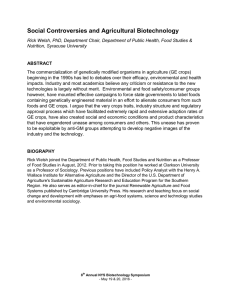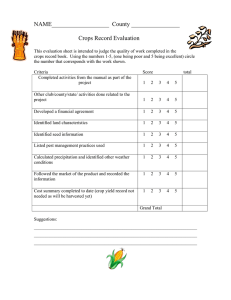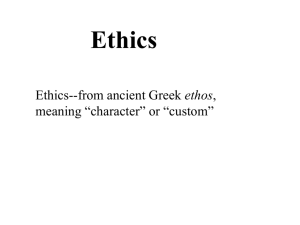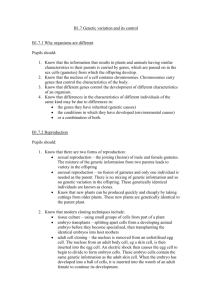Biotechnology 8 Summative Exam - GMOs, Bacteria, and More
advertisement
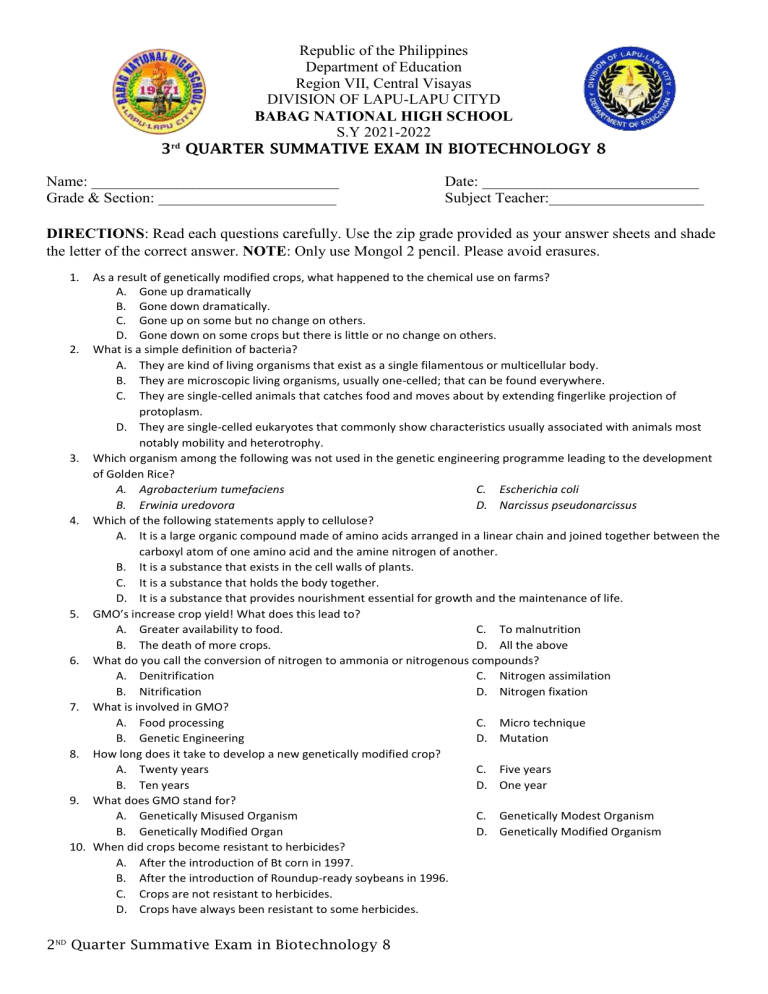
Republic of the Philippines Department of Education Region VII, Central Visayas DIVISION OF LAPU-LAPU CITYD BABAG NATIONAL HIGH SCHOOL S.Y 2021-2022 rd 3 QUARTER SUMMATIVE EXAM IN BIOTECHNOLOGY 8 Name: ________________________________ Grade & Section: _______________________ Date: ____________________________ Subject Teacher:____________________ DIRECTIONS: Read each questions carefully. Use the zip grade provided as your answer sheets and shade the letter of the correct answer. NOTE: Only use Mongol 2 pencil. Please avoid erasures. 1. As a result of genetically modified crops, what happened to the chemical use on farms? A. Gone up dramatically B. Gone down dramatically. C. Gone up on some but no change on others. D. Gone down on some crops but there is little or no change on others. 2. What is a simple definition of bacteria? A. They are kind of living organisms that exist as a single filamentous or multicellular body. B. They are microscopic living organisms, usually one-celled; that can be found everywhere. C. They are single-celled animals that catches food and moves about by extending fingerlike projection of protoplasm. D. They are single-celled eukaryotes that commonly show characteristics usually associated with animals most notably mobility and heterotrophy. 3. Which organism among the following was not used in the genetic engineering programme leading to the development of Golden Rice? A. Agrobacterium tumefaciens C. Escherichia coli B. Erwinia uredovora D. Narcissus pseudonarcissus 4. Which of the following statements apply to cellulose? A. It is a large organic compound made of amino acids arranged in a linear chain and joined together between the carboxyl atom of one amino acid and the amine nitrogen of another. B. It is a substance that exists in the cell walls of plants. C. It is a substance that holds the body together. D. It is a substance that provides nourishment essential for growth and the maintenance of life. 5. GMO’s increase crop yield! What does this lead to? A. Greater availability to food. C. To malnutrition B. The death of more crops. D. All the above 6. What do you call the conversion of nitrogen to ammonia or nitrogenous compounds? A. Denitrification C. Nitrogen assimilation B. Nitrification D. Nitrogen fixation 7. What is involved in GMO? A. Food processing C. Micro technique B. Genetic Engineering D. Mutation 8. How long does it take to develop a new genetically modified crop? A. Twenty years C. Five years B. Ten years D. One year 9. What does GMO stand for? A. Genetically Misused Organism C. Genetically Modest Organism B. Genetically Modified Organ D. Genetically Modified Organism 10. When did crops become resistant to herbicides? A. After the introduction of Bt corn in 1997. B. After the introduction of Roundup-ready soybeans in 1996. C. Crops are not resistant to herbicides. D. Crops have always been resistant to some herbicides. 2ND Quarter Summative Exam in Biotechnology 8 11. What effect does eat genetically modified foods have on your genes? A. It could cause your own genes to absorb the excess genes. B. It could cause your own genes to mutate. C. It has no effect on your genes. D. The effects on human genetics aren’t known 12. Can genes escape from genetically modified crops and jump to other plants? A. Yes, and often do. B. No, genes cannot move from species to species without human intervention. C. Only during rare climatic conditions. D. Only to some crops, but those crops aren’t genetically modified. 13. Can scientists predict with certainty where an inserted gene will go on a plant chromosome? A. Genes are inserted on the proper chromosome, but there is no control on where it goes on the chromosome. B. It’s just a shot in the dark. C. Scientists have a general idea of where the gene will go and what it will do to the plant. D. With modern genetic techniques, scientists can insert genes precisely 14. What are the current benefits of having foods made from genetically modified crops? A. They allow farmers to greatly increase the number of crops produced. B. They improve convenience for consumers, e.g. by creating foods with longer shelf lives. C. They improve farm profitability and make some farmers' jobs easier. D. They improve the nutritional quality of foods. 15. Are foods derived from genetically modified crops nutritionally superior? A. Yes, they offer some health advantages over foods produced from conventional crops. B. Yes, they offer substantial health advantages over foods produced from conventional crops. C. No, they are neither better nor worse than foods from conventional crops. D. No, they are slightly less healthful than foods from conventional crops. 16. Two bacteria most useful in genetic engineering are _________________? A. Rhizobium and Azobacter C. Escherichia and Agrobacterium B. Nitrosomonas and Klebsilla D. Rhizobium and Diplococcis 17. What does the second critical research area of biotechnology provide? A. Optimum conditions for the catalyst C. An impure form of catalyst B. The pure form of catalyst D. Purification of products 18. What is the green revolution related to? A. Forest C. Agriculture B. Go Green D. Biotechnology 19. What is an important objective of biotechnology in agriculture? A. to decrease seed number C. to increase phosphorous, nitrogen B. to produce pest-resistant varieties of production plants D. to reduce the number of plants 20. A genetically modified crop is __________________. A. mature crop C. raised to green manure B. infected crop D. transgenic crop 21. What is an example of abiotic stress? A. Pest C. Drought B. Insect D. Vectors 22. Genetically modifies rice is enriched with what type of vitamin? A. K C. A B. D D. E 23. Bt toxin is produced by a bacterium called __________________. A. Bacillus thuringiensis C. Bacillus thermophilus B. Bacillus anthracis D. Bacillus subtilis 24. GMOs can minimize the use of fertilizers. A. TRUE B. FALSE 25. What is the first transgenic crop? A. Potato B. Brinjal 2ND Quarter Summative Exam in Biotechnology 8 C. Cotton D. Tobacco 26. Which part of the tobacco plant is infected bycMeloidogyne incognitia? A. Leaf C. Stem B. Root D. Flower 27. In Bt Cotton, the Bt toxin present in plant tissue as protoxin is converted into active toxin due to__________ A. Alkaline PH of the insect gut D. Presence of conversion factors in insect B. Acidic pH of the insect gut gut C. Action of gut microorganism 28. Tobacco plant resistant to a nematode have been developed by the introduction of DNA that produced in the host cells__________ A. Both sense and anti-sense RNA C. An antifeedant B. A particular hormone D. A toxic protein 29. Genetic engineering has been successfully used for producing: A. Transgenic mice for testing safety of polio vaccine before use in humans B. Transgenic models for studying new treatments for certain cardiac diseases C. Transgenic cow - Rosie which produces high fat milk for making ghee D. Animals like bulls for farm work as they have super power 30. The silencing of mRNA has been used in producing transgenic plants resistant to: A. Boll worms C. Nematodes B. White rusts D. Bacterial blights 31. Which one of the following is now being commercially produced by biotechnological procedures_________? A. Nicotine C. Morphine B. Quinine D. Insulin 32. What are some of the characteristics of Bt cotton? A. Long fibre and resistance to aphids B. Medium yield, long fibre and resistance to beetle pests C. High yield and production of toxic protein crystals which kill dipteran pests D. High yield and resistance to bollworms 33. Which of the following is a product produced by biotechnology? A. Bacteria C. Vaccine B. Skin D. Plants 34. Which bacterium is used in the prod1uction of insulin by genetic engineering? A. Saccharomyces C. Escherichia B. Rhizobium D. Mycobacterium 35. How do you call the procedure of making multiple copies of the desired DNA template? A. cloning C. r-DNA technology B. transferring D. genetic engineering 36. Plasmids are used as cloning vectors for which of the following reasons? A. Can be multiplied in culture B. Self-replication in bacterial cells C. Can be multiplied in laboratories with the help of enzymes D. Replicate freely outside bacterial cells 37. What is a transgenic plant? A. Plant with a gene from other plants C. Mutated plant B. Improved plant for a precise agronomic D. None of the above trait 38. Biotechnologies consisting of the use of biological systems (bacteria) for the manufacture, transformation or degradation of molecules through enzymatic or fermentation processes for industrial purposes, are called___________. A. Yellow biotechnologies C. Green biotechnologies B. Blue biotechnologies D. White biotechnologies 39. Which among the following is incorrect? A. Hybridization of DNA by a probe requires sequence similarity between the two components. B. The circular and linear DNAs, containing N restriction sites for a restriction enzyme, give, respectively, N and N + 1 fragments, once cut by this enzyme. C. Cloning of a recombinant DNA means the isolation of cell colonies containing the construct of the specific recombinant DNA. D. The EcoRI endonuclease, the cut of which on a circular DNA gives 4 fragments, is in favor of the presence of 4 restriction sites. 2ND Quarter Summative Exam in Biotechnology 8 40. The expression of a transgene in the target tissue is identified by a _________. A. Transgene C. Enhancer B. Promoter D. Reporter 41. What are the current benefits of having foods made from genetically modified crops? A. They improve farm profitability and make some farmers' jobs easier. B. They allow farmers to greatly increase the amount of crops produced. C. They improve convenience for consumers, e.g. by creating foods with longer shelf lives. D. They cause less damage to the environment than conventional chemical-intensive agriculture. 42. Of the foods we eat, how much contains the genetic material DNA? A. 20 percent. C. 80 percent. B. 50 percent. D. Nearly 100 percent 43. Most foods derived from genetically modified crops contain: A. The same number of genes as food produced from conventional crops. B. b. The same number of genes as foods produced from hybrid crops. C. c. One or two additional genes. D. d. Hundreds of additional genes. 44. What effect does eating genetically modified foods have on your genes? A. It could cause your own genes to mutate. B. It could cause your own genes to absorb the excess genes. C. It has no effect on your genes. D. The effects on human genetics aren't known. 45. Are foods derived from genetically modified crops nutritionally superior? A. Yes, they offer substantial health advantages over foods produced from conventional crops. B. Yes, they offer some health advantages over foods produced from conventional crops. C. No, they are neither better nor worse than foods from conventional crops. D. No, foods produced from genetically modified crops are a known health risk. 46. What is involved in GMO? A. Genetic Engineering C. Food processing B. Mutation D. Microtechnique 47. What happens to plants and animals during genetic modification? A. more desirable genes are transferred to a new species B. genes are removed from one organism and transferred to another C. plants or animals are given traits that they do not typically have D. All of the above 48. Which of the following is not an example of an advantage of genetic engineering? A. farmers may need to use less pesticides B. modified cotton, corn, and soybeans help create "superweeds" C. can improve nutrition and taste of some foods D. may have a greater resistance to spoilage ‘’I CAN DO ALL THINGS THROUGH CHRIST WHO STRENTHENS ME’’ -Philippians 4:13 Prepared by : MS. MARY CELKY N. ESPINOSA 2ND Quarter Summative Exam in Biotechnology 8
